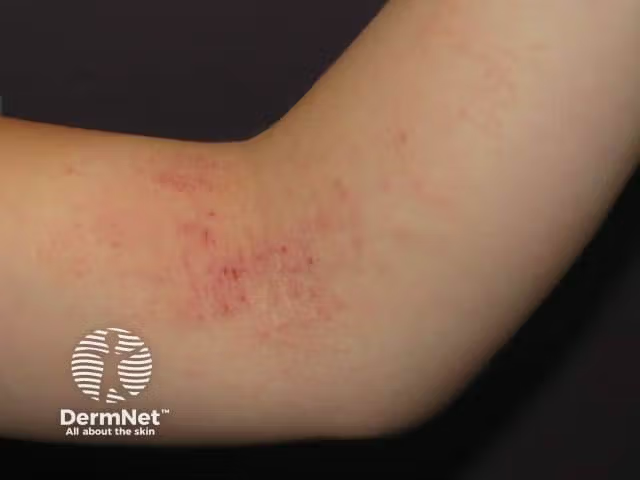- Case-Based Roundtable
- General Dermatology
- Eczema
- Chronic Hand Eczema
- Alopecia
- Aesthetics
- Vitiligo
- COVID-19
- Actinic Keratosis
- Precision Medicine and Biologics
- Rare Disease
- Wound Care
- Rosacea
- Psoriasis
- Psoriatic Arthritis
- Atopic Dermatitis
- Melasma
- NP and PA
- Skin Cancer
- Hidradenitis Suppurativa
- Drug Watch
- Pigmentary Disorders
- Acne
- Pediatric Dermatology
- Practice Management
- Prurigo Nodularis
- Buy-and-Bill
News
Article
Balancing Biologics and Corticosteroids: Tailored Approaches for Managing Atopic Dermatitis
Author(s):
Key Takeaways
- Personalized treatment strategies in AD management consider patient history, concerns, and specific needs for optimal outcomes.
- Biologics like dupilumab target IL-4 and IL-13 pathways, offering promising results for moderate to severe AD cases.
Alexandra Golant, MD, led a Dermatology Times Case-Based Roundtable® event that focused on advancing therapeutic strategies for atopic dermatitis.
Alexandra Golant, MD

“When I talk to patients, I always like to say, ‘I view myself as the waiter. I am here to present you the menu and then help you if you ask me for my recommendations.’ We all have that shared decision-making conversation differently with our patients,” said Alexandra Golant, MD, during a recent Dermatology Times Case-Based Roundtable® event, “Breaking Barriers in Atopic Dermatitis Management: Optimizing Treatment Pathways.”
Golant, a board-certified dermatologist, the medical director of the Dermatology Faculty Practice at the Kimberly and Eric J. Waldman Department of Dermatology, and the program director of the Dermatology Residency Program at Mount Sinai in New York, New York, led a roundtable discussion with attendees that focused on advancing therapeutic strategies for atopic dermatitis (AD) through case-based discussions.
Key objectives of the event included the following:
- Identify factors influencing treatment selection, such as patient history, comorbidities, and previous treatments, to optimize therapeutic outcomes for patients with AD.
- Evaluate the therapeutic profiles of biologics and other advanced therapies in terms of efficacy, onset of action, and sustainability of response.
- Explore how targeting IL-4 and IL-13 pathways addresses underlying inflammatory mechanisms, reduces symptom severity, and improves skin barrier function in patients with AD.
What follows are summaries of 3 patient cases that were discussed, highlighting challenges, treatment approaches, and outcomes.
Case 1: 27-Year-Old Woman With Moderate to Severe AD
Patient Presentation
- Symptoms: eczematous lesions affecting less than 20% of the body surface area (BSA), primarily on arms, legs, and torso
- Impact: intense pruritus disrupting sleep and work confidence
- History: long-standing AD since childhood with significant mental health burden
The patient had previously used emollients, topical corticosteroids as needed, and oral corticosteroids to manage her AD. The patient, a teacher, reported that the AD was affecting her social interactions and confidence in the classroom. She was concerned about long-term topical steroid use and wanted to find a more sustainable treatment approach and achieve long-term control of the AD.
Case Questions
- What aspects of the case influence your choice of therapy?
- How can clinicians address the patient’s concerns about long-term corticosteroid use while ensuring effective management of the condition?
- What other treatment options may be considered for this patient to achieve better long-term control of AD?
Golant reviewed with attendees the type 2 inflammatory pathway responsible for AD, which includes primary immune cells, such as helper T cells type 2, group 2 innate lymphoid cells, mast cells, basophils, and eosinophils, and key cytokines such as IL-4, IL-5, IL-13, and IL-31.
Dupilumab (Dupixent; Sanofi and Regeneron) targets IL-4 and IL-13 and is indicated for the treatment of patients 6 months and older with moderate to severe AD. Tralokinumab-ldrm (Adbry; LEO Pharma) and lebrikizumab-lbkz (Ebglyss; Eli Lilly and Company) both target IL-13 and are approved for the treatment of AD in patients 12 years and older.
Golant noted that IL-4 and IL-13 have overlapping but not redundant functions in type 2 inflammation. IL-4 drives T-cell differentiation in the early stages of AD, and IL-13 affects peripheral tissue cells and is involved in later stages of immune response. Targeting IL-4 is considered an early intervention strategy in AD pathogenesis, and dual blockade (IL-4/IL-13) targets multiple steps in the AD cascade to provide rapid and sustained therapeutic response.
Treatment Approach
After the original clinician considered the patient’s treatment history and comorbidities, the decision was made to initiate a 600-mg subcutaneous loading dose of dupilumab, followed by 300 mg every 2 weeks. She continued daily emollient use and triamcinolone 0.1% cream as needed.
At a follow-up visit after 16 weeks, the patient reported a marked improvement in eczema severity, with a 70% reduction in her Eczema Area Severity Index (EASI) score. She had experienced a significant reduction in pruritus, which improved her sleep and confidence at work. Mild conjunctivitis was noted during treatment and successfully managed with artificial tears and an ophthalmology consultation.
Case 2: 36-Year-Old Woman With Moderate AD
Patient Presentation
- Symptoms: persistent itching and erythema, predominantly on hands
- Impact: difficulty sleeping due to itch; reluctance to use topical corticosteroids on hands
- History: flares since childhood; family history of atopy
The patient presented with persistent itching and erythema, particularly on her hands, affecting 8% of her BSA. She reported difficulty sleeping due to itch and expressed reluctance to use topical corticosteroids due to concerns about long-term adverse effects, especially on sensitive areas such as the hands. Her treatment history included short courses of oral antihistamines for severe itching episodes, topical corticosteroids, and daily emollients. The patient was eager to begin treatment with a fast onset of action but did not want a systemic treatment.
Case Questions
- What is your impression of this case? What challenges does this case present with, if any?
- How do you approach patients who are unhappy with their current topical treatments?
- How do you address concerns or misconceptions that patients might have about discontinuing steroid-based treatments for a different mechanism of action or therapy?
Treatment Approach
After the clinician and patient discussed options, the decision was made to initiate a nonsteroidal topical therapy to address the patient’s concerns about corticosteroids. The patient was educated on treatment mechanisms, the efficacy of nonsteroidal options, and the importance of adherence to achieve optimal results.
At an 8-week follow-up, the patient had experienced a 50% reduction in her EASI score and a marked reduction in itch, which significantly improved her sleep. She reported no adverse effects and expressed satisfaction with her treatment, noting reduced anxiety about future therapies.
“Many of these patients were offered for so many years, sometimes so many decades, different versions of topicals—topical steroids in particular—that there seems to be this renaissance of patients being super hyper aware of them. I say, ‘With [correct]usage, they are safe. They’re not to be feared,’” Golant said.
Case 3: 7-Year-Old Boy With Severe AD
Patient Presentation
- Symptoms: 12% BSA affected (arms, trunk); persistent itching causing sleep disturbances
- Impact: below 50th percentile in height for age, with parents concerned about topical corticosteroid safety
- History: moderate to severe AD since infancy
The patient presented with severe AD, affecting 12% of his BSA, including the arms and trunk. Persistent itching caused sleep disturbances, and the child was below the 50th percentile for height, raising concerns about growth. His parents were hesitant about using topical corticosteroids due to safety concerns but sought an effective therapy beyond moisturizers.
Treatment Approach
The decision was made to initiate dupilumab based on the severity of the AD and the condition’s impact on the child’s growth and quality of life. The parents were engaged in discussions about the benefits of biologics and the importance of timely intervention.
“We’re just seeing the effects of early intervention in kids, and we’re not going to fully know the answer to this until these children become adults,” said Golant.
After 16 weeks, the child had achieved significant improvement in eczema severity, with a 50% reduction in his EASI score and an Investigator’s Global Assessment score of 0 to 1. His sleep disturbances resolved, and his parents reported satisfaction with the treatment
Looking Ahead
These cases highlight the importance of personalized treatment approaches in AD that consider patient history, concerns, and specific needs (Table 1 and Table 2). Biologics such as dupilumab offer promising results for moderate to severe cases, and nonsteroidal therapies provide alternatives for patients who are hesitant about corticosteroids. As Golant noted, patient education and collaboration are pivotal to achieving optimal outcomes.
Table 1. EASI Score Improvements Across AD Cases
AD, atopic dermatitis; EASI, Eczema Area Severity Index.
Table 2. Treatment Selection Chart
AD, atopic dermatitis.






